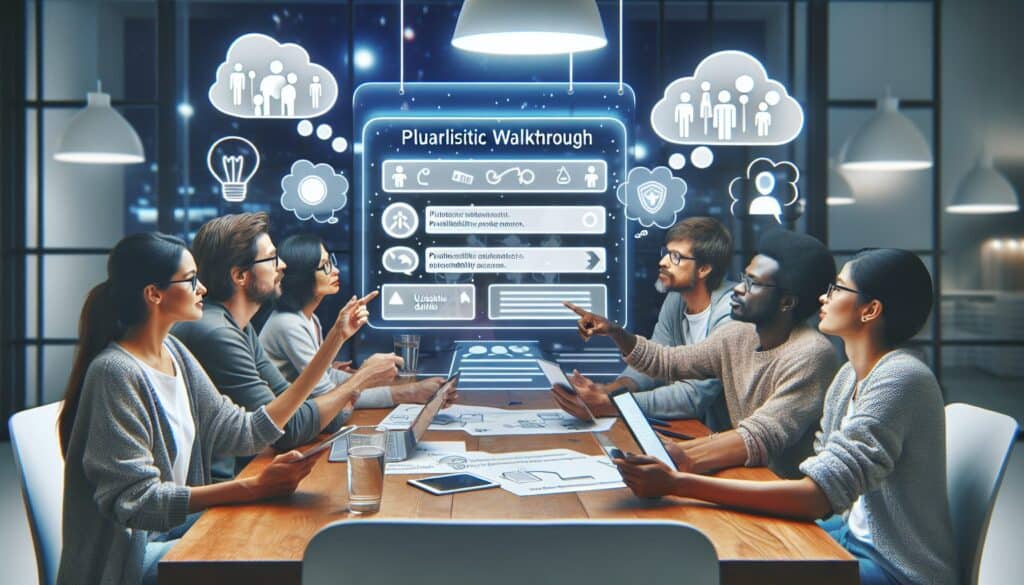A usability inspection method where a group of users, developers, and usability experts collaboratively step through a task scenario, discussing usability issues at each step.
- المنهجيات: العملاء والتسويق, الاقتصاد, لين سيجما, تصنيع, إدارة المشاريع, الجودة
Pluralistic Walkthrough

Pluralistic Walkthrough
- تقييم التصميم, التفكير التصميمي, التصميم المرتكز على الإنسان, التصميم التفاعلي, سهولة الاستخدام, تجربة المستخدم (UX), واجهة المستخدم (UI), اختبار المستخدم, تصميم يركز على المستخدم
الهدف:
كيفية استخدامه:
- The group works together to identify potential problems from different perspectives, simulating the user experience and commenting on design elements and flow.
الايجابيات
- Brings diverse perspectives to the evaluation; can identify a wider range of usability issues; promotes shared understanding and buy-in for design changes.
سلبيات
- Can be time-consuming to organize and conduct; requires a skilled facilitator to manage group dynamics and keep the session focused; groupthink can be a potential issue if not managed.
الفئات:
- تصميم المنتج, الجودة
الأفضل لـ
- Evaluating the usability of a system by having a group of users, developers, and usability experts walk through task scenarios together.
In the realm of product design and development, the Pluralistic Walkthrough is particularly beneficial during the early phases of a project, such as conceptualization and initial design, where user involvement is pivotal for ensuring usability. This methodology is frequently adopted in various sectors including software design, web application development, and consumer electronics, where user interface and interaction are paramount. During these collaborative sessions, participants typically include end-users who represent different demographics, designers, developers, and usability specialists, who collectively contribute their thoughts as they step through task scenarios, mimicking the user’s experience with the system. The involvement of diverse stakeholders not only enriches the evaluation with multifaceted feedback but also turbocharges team cohesion and understanding of user needs. For instance, in a project aimed at creating an educational app, educators, students, and designers might engage in a Pluralistic Walkthrough to identify pain points from all angles, such as navigation difficulties or content accessibility. This approach enables teams to capture a broader range of usability concerns and promotes a shared commitment to the design revisions, laying a foundation for تتمحور حول المستخدم iterations that can ultimately lead to more effective and engaging products. Additionally, employing this methodology can yield data that is invaluable for subsequent stages of a project, such as development or closer usability testing, ensuring a smoother transition from design to implementation.
الخطوات الرئيسية لهذه المنهجية
- Define task scenarios relevant to the system being evaluated.
- Participants individually review the scenarios to note potential usability issues.
- Conduct a group discussion where each participant shares their observations.
- Simulate the user experience step-by-step for each task scenario.
- Encourage diverse viewpoints to examine design elements and workflows.
- Identify and document usability problems as a collective.
- Discuss possible design solutions or modifications based on the findings.
نصائح للمحترفين
- Encourage participants to articulate their assumptions and expectations during the walkthrough to uncover unspoken التحيزات and preconceptions.
- Utilize a clear and structured scenario framework to guide discussions, ensuring all aspects of the user experience are systematically evaluated.
- Record the insights and feedback in real-time, categorizing them by severity and frequency to prioritize design changes effectively.
لقراءة عدة منهجيات ومقارنتها, نوصي باستخدام
> مستودع المنهجيات الشامل <
مع أكثر من 400 منهجية أخرى.
نرحب بتعليقاتكم على هذه المنهجية أو المعلومات الإضافية على قسم التعليقات أدناه ↓، وكذلك أي أفكار أو روابط متعلقة بالهندسة.
السياق التاريخي
1986
(إذا كان التاريخ غير معروف أو غير ذي صلة، على سبيل المثال "ميكانيكا الموائع"، يتم تقديم تقدير تقريبي لظهوره الملحوظ)

منشورات ذات صلة
استبيانات الانزعاج العضلي الهيكلي
الاختبار متعدد المتغيرات (MVT)
تحليل الانحدار المتعدد
أنظمة التقاط الحركة
طريقة MoSCoW
اختبار متوسط المزاج